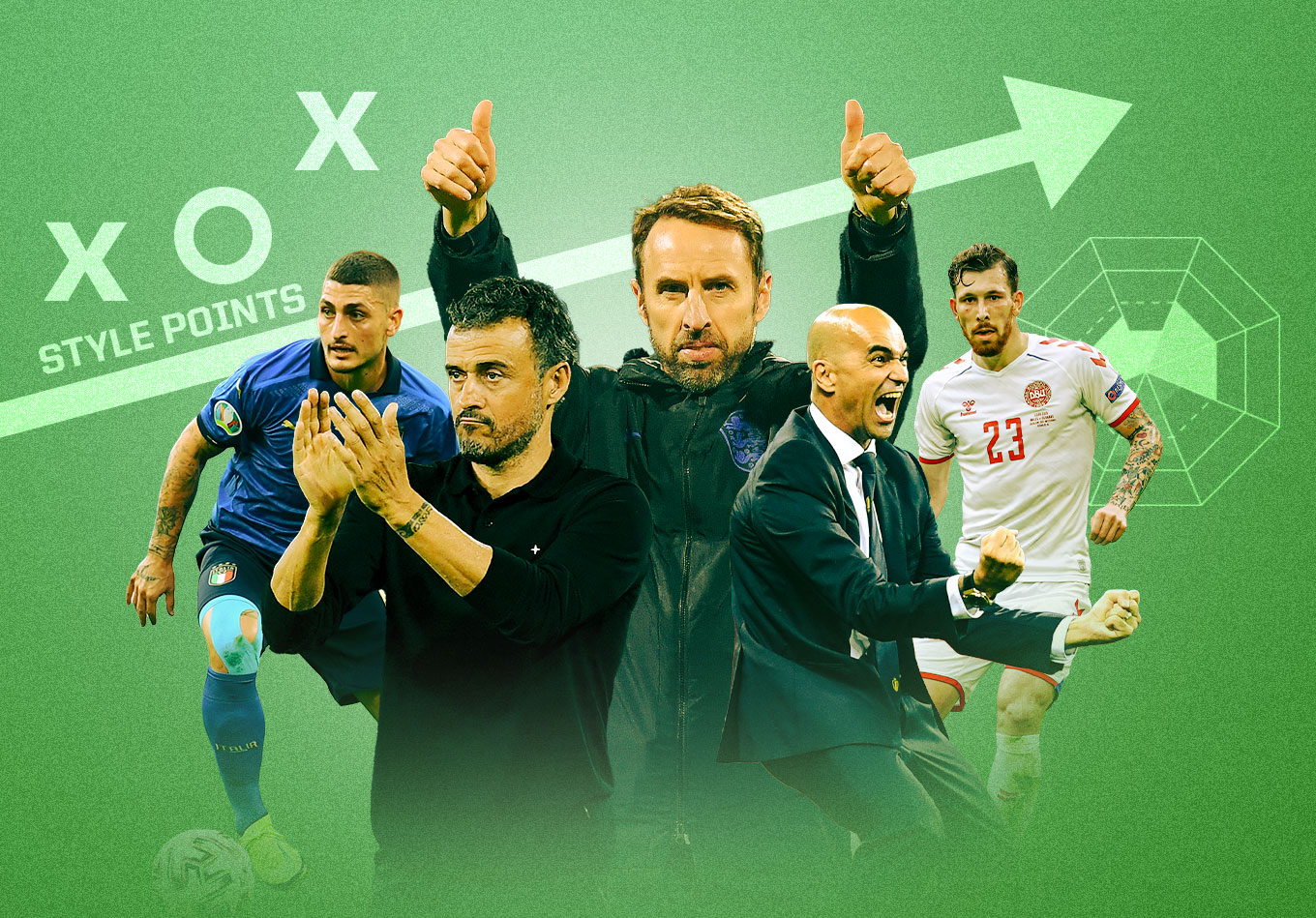It’ll never be enough for us to appreciate or dismiss football teams based on results alone. And good on us because, really, what fun would that be. Managers or players might be less annoyed with us if we did, but we’d have nothing to talk about on days like the last two when the void feels very real after growing used to watching two or three matches a day.
Rather than letting the results stand for what they are, we say Team X played brave football and deserved a better result, or Team Y played cynical football and may continue advancing but won’t win over any neutral supporters along the way. If we happen to support that team, we spit out the phrase that’s tournament football!, shrug and look down at our phone.
But those statements, however right we know they are, lack evidence. We know what we see but we don’t always know how to back it up.
One way we assess team style statistically is by measuring the speed with which teams progress up the field and comparing it to the average number of passes made in their sequences. So first, here’s an overview of the quarter-finalists’ styles (purple) compared among the rest of the 24-team field (red).
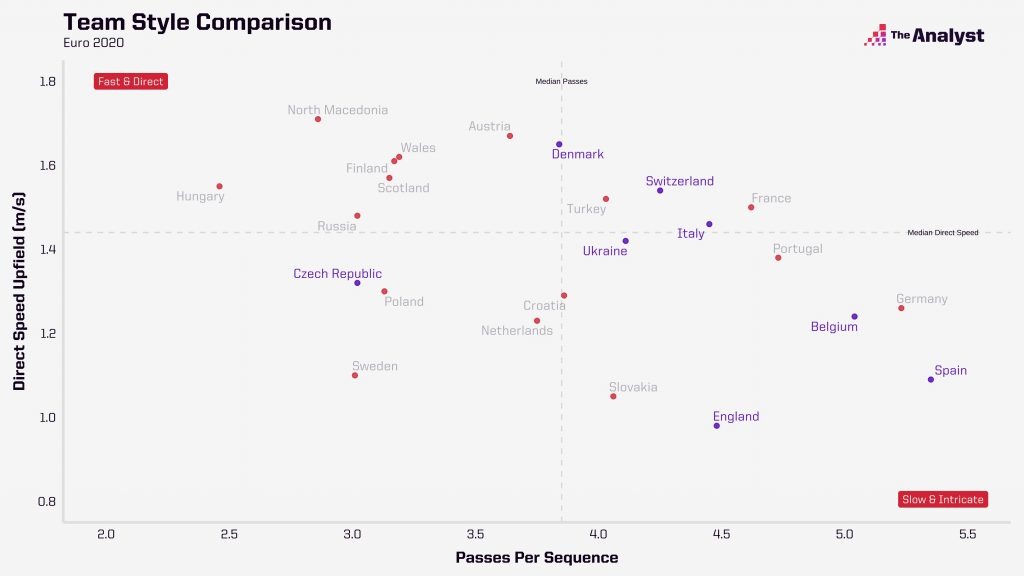
By comparing teams this way we see Spain, Belgium and England tend not to advance the ball up the pitch as quickly as other remaining teams, but that doesn’t mean those three teams are always similar in style. If Spain are making that many passes with comparatively low speed, it unsurprisingly means they’re making more passes laterally and taking their time getting forward. But that doesn’t necessarily mean they’re not moving the ball quickly. We’ll come back to that. Italy, meanwhile, move faster up the pitch, but they do so while making a similar number of passes per sequence as England, so they’re probably playing more quick one- and two-touch and perhaps more vertical balls in their sequences without resorting to going long.
To assess that level of detail, we can also measure style within particular contexts or phases to differentiate these teams a bit more. Those are counter attack, high press, crossing, direct play, fast tempo (a player releases the ball to a teammate in less than two second or the average speed of the player while carrying the ball is above four metres per second), maintenance (possession in one’s own half), build up and sustained threat. The dotted line in the middle of the radars below is the tournament average (0%). The averages in the pink pills are the possessions in that style per match, and the +/- percentages are that team’s variance from the tournament average.
We’ll start with a team that’s traditionally been criticized for their style but has done plenty in recent months to repair that image.
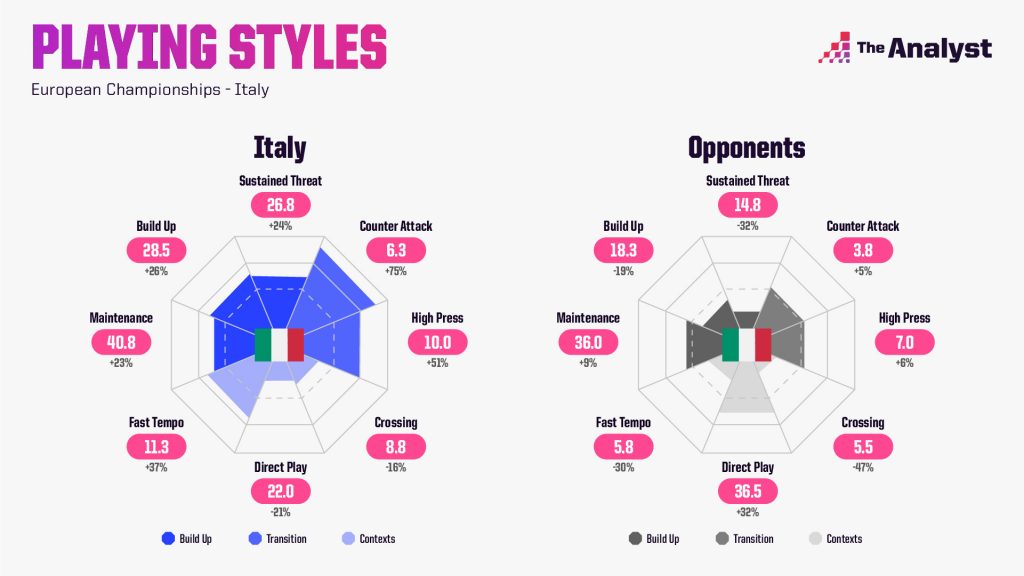
You’ve been told for weeks now that Italy play exciting football and the defensive days of Maldini and Cannavaro are gone. Or at least on hold.
Perhaps that’s what you also elicit from this graphic, but perhaps you know they’ve played Turkey, Switzerland, Wales and Austria. It’ll be interesting to see what this graphic looks like after Italy play Belgium, but for now let’s focus on what we’ve got. When we distill it down to these numbers, Italy are in fact the only team to be above the tournament average in all phases other than direct play and crossing. Their possession-based styles of maintenance, build up and sustained threat are all at least 24% above the Euro 2020 average, their fast tempo play is fourth behind Spain, Germany and France.
Additionally, their transition play has been consistent and occasionally effective. Only one of their goals has come from a counter so far, but they’re averaging 2.8 shots from counters per match, so more may be on the way. Their press has resulted in two goals, which is tied for the tournament lead with the Netherlands.
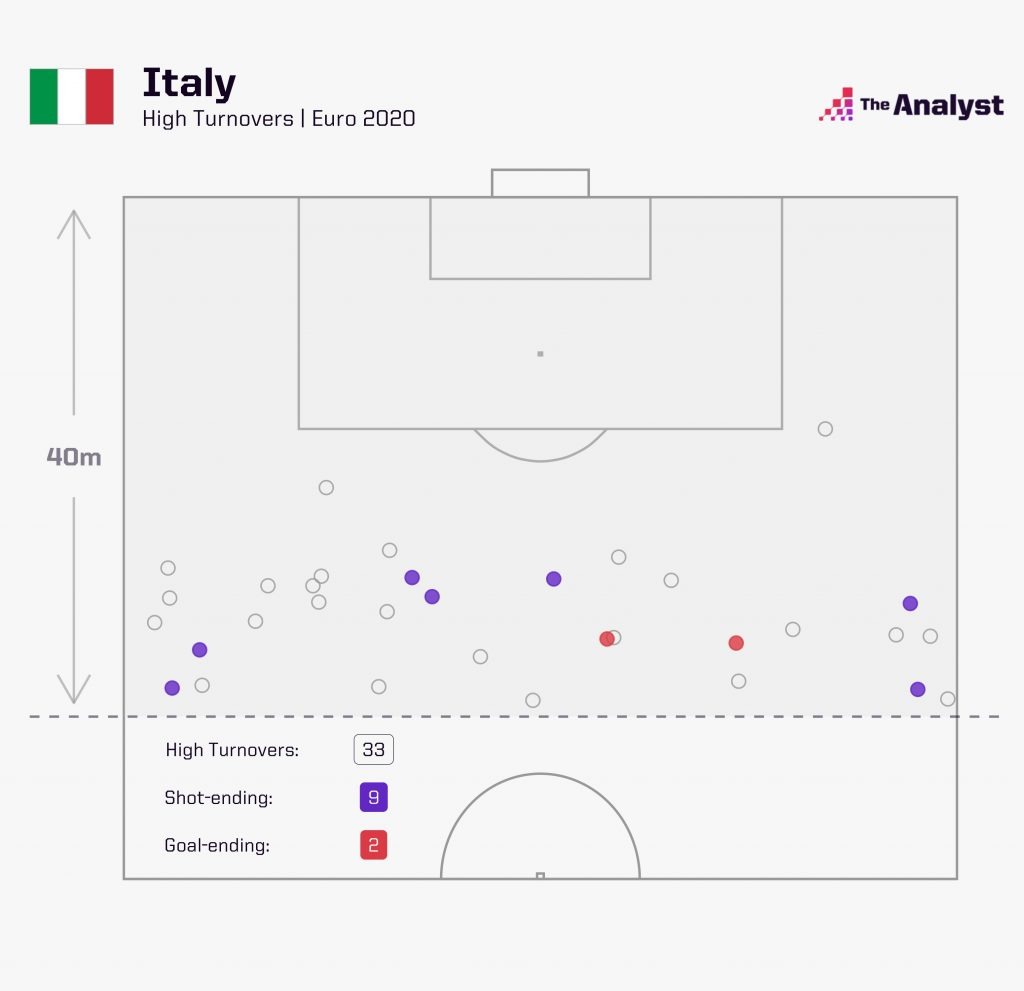
They’ve done this in part without Marco Verratti, who was held out of the start of the tournament. What measurable assets does the PSG man bring to Italy’s style? He’s second in build-up involvement (13% of Italy’s on-pitch actions in this phase) and third in fast tempo (12%), and it’s only taken him 157 minutes to generate the most chances created from open play in the tournament (eight). Oh, and a 94% pass completion rate, which is important for this team when considering how they work the ball into the attacking third. Verratti isn’t in the top three on the team in sustained threat involvement – that’s been Leonardo Spinazzola, Lorenzo Insigne and Domenico Berardi – but he’s key to getting the ball there, and when they do, the ball often ends up connecting with white nylon. They’re scoring 1.5 goals per match from possessions that include the sustained threat style, which seems ridiculous until you learn Spain are at 1.8…
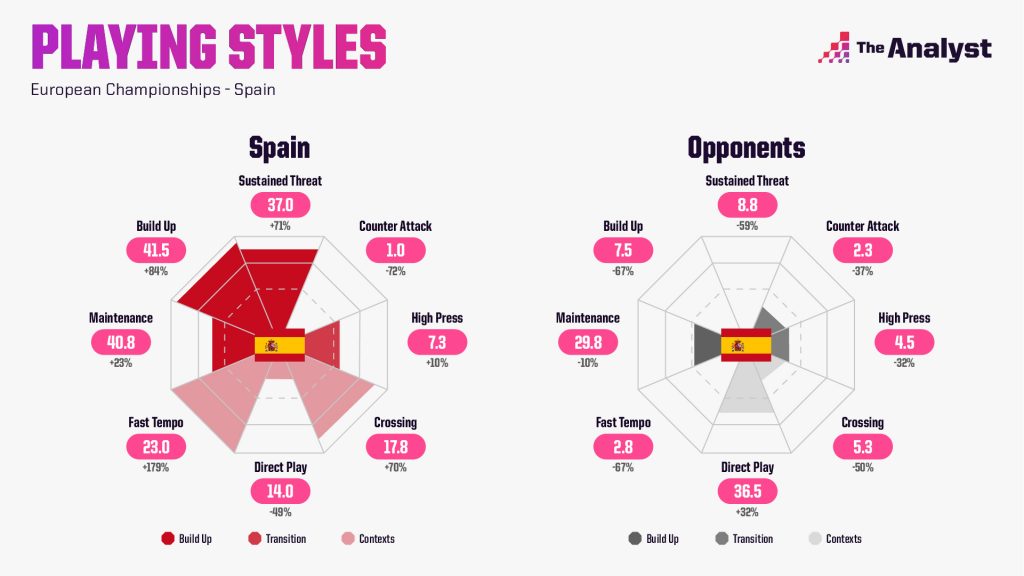
Spain tend to possess the ball in their opponents’ halves. Their opponents do not. You didn’t need a fancy graphic to know that. That combo can be a good starting point for winning football matches. Add in some quickness – Spain also lead the tournament in fast tempo possessions – and you might have a recipe for entertaining football on top of that.
We should clarify what we mean by fast tempo here, particularly since the first graphic plotted Spain as slow and intricate. That’s measuring those 24 teams’ metres per second progressed up the pitch during their sequences. Fast tempo is more about pace in the attacking half regardless of the direction the ball is moving, which Spain do more than anyone in the tournament.
As for who’s most involved, it’s Pedri for fast tempo, sustained threat and build up. He’s responsible for 15% of Spain’s actions in those styles when he’s on the pitch. That’s resulted in a 6.48 xG from sequences in which Pedri is involved, which is by far the highest in the tournament. For better context, only 17 players in the entire tournament are above half that mark. Teammate Aymeric Laporte is second (5.09) in large part because he’s had the most open-play passes at the tournament, and Kai Havertz is third (4.96).
Spain’s counter attack is unsurprisingly non-existent, and much of the Spanish squad would walk off the pitch before playing the ball long. Their direct play (14.4) ranks last at Euro 2020 and by some distance – Germany (21.3) and Belgium (25.1) are their closest company.
Luis Enrique’s team do press a bit, which is supported by their 8.2 PPDA (opponent passes per defensive action) being the lowest in the entire tournament. That indicates they’re not allowing opponents to possess without actively defending, but as for actual high press regains, their 7.3 per match rank eighth and behind fellow quarter-finalists Italy (10.0) and Denmark (8.3), which brings us to…
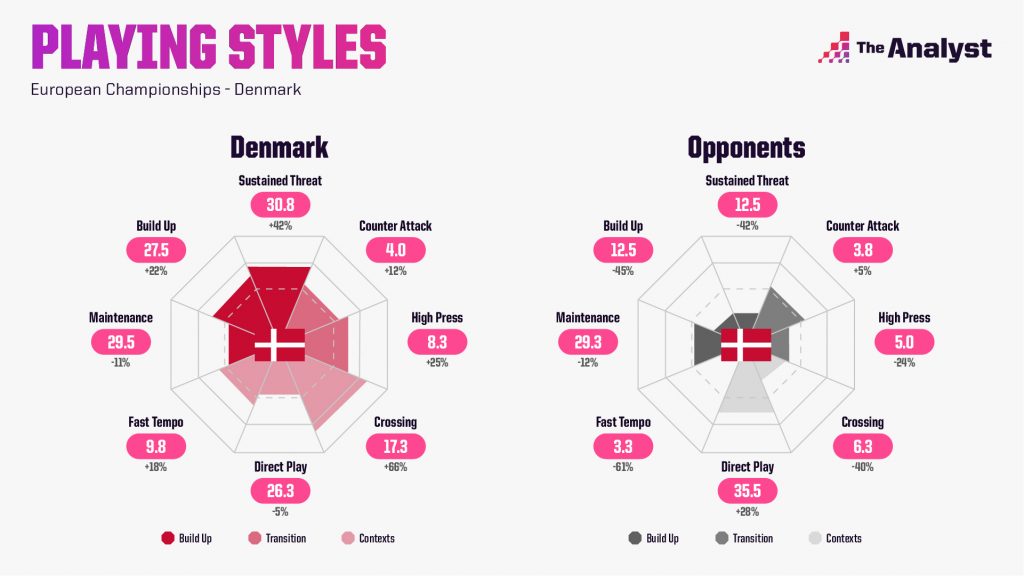
Recall direct speed from the vertical axis of the first graphic. Denmark are fastest among the eight remaining teams, which makes you think they’re settling for knocking the ball long. That’s not necessarily true. They’re actually below tournament average for direct play possessions. Instead, they’re getting the ball forward through passes of less than 20 metres.
Denmark are above tournament average in six of the eight phases of play, and what’s particularly impressive here – and hints at a level of excitement and consequential possession – is that Denmark have more sustained threat than they have build up and more build up than they have maintenance possession. So they’re keeping the ball farther up the pitch rather than knocking the ball around the back four. An example of that would be Croatia, who lead the tournament with more than 41 maintenance possessions per match.
What you may already know: Pierre-Emile Højbjerg has three assists from open play. What you probably don’t know: his 34 ball recoveries lead the tournament, and that amounts to him accounting for 25% of Denmark’s counter-attack regains when he’s on the pitch while his 21% share of counter-attack distance passed is the most among outfield players. He’s also been involved in more shot-ending sequences (30) than anyone in the tournament, so a player who’s hardly known for his offensive contributions with Tottenham has been about as dynamic as Denmark’s overall style.
Many of his potential semi-final opponents know him well…
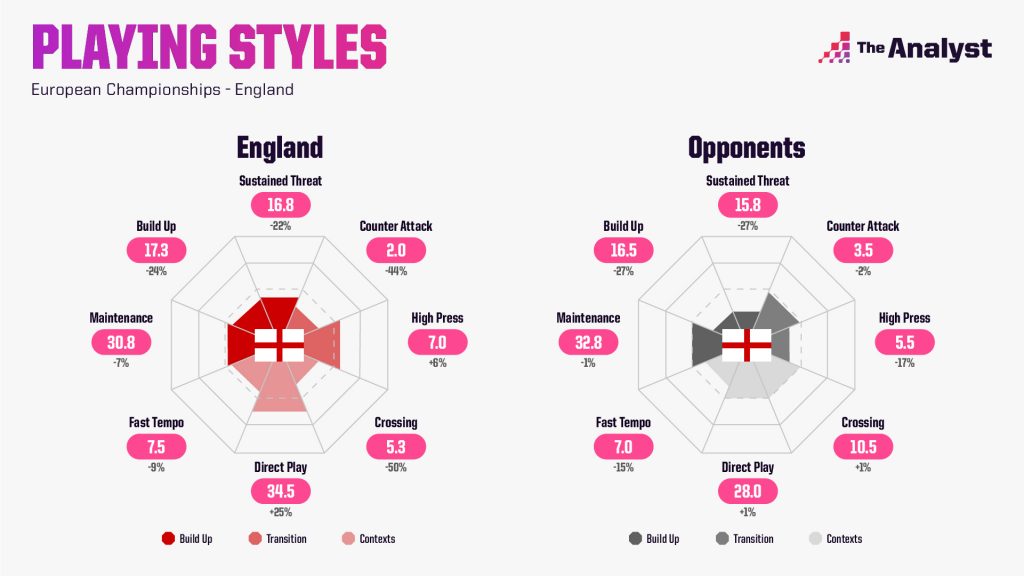
Here’s where the results v style argument in tournament football gets interesting. England beat Germany. No one should be picky about how they beat Germany, no matter which version of Germany they beat. And it should be stated that you can’t fault a team for playing conservatively when their opponents aren’t providing much in the way of threat at the other end, much less getting a lead to entice more creativity and risk from Gareth Southgate’s side. I suspect we’d see a far more rousing England effort if one of their opponents were so bold as to score a goal against them. Quality defence should also be applauded.
However, to a world of neutral viewers, England haven’t been the most thrilling team to watch at times, and the data supports that. Their maintenance possession in the back is the only of the three possession-based styles near tournament average. Snooze. They’re not only playing well below tournament average in build up and sustained threat, but they’re also not countering. Double snooze. Their press has resulted in two shots, which is last with Ukraine and Belgium among the remaining eight. And their direct play (balls with a forward distance gained of 20 metres or more) is well above the tournament average.
All of England seems to want to see more of Jack Grealish, and all of England + Erling Haaland want to just see Jadon Sancho, but at what cost? Their opponents are doing nothing much above average, and it’s resulting in below-average shots per match conceded by England from all eight styles. So it’s hard to start arguing for huge changes, especially given the opponents and potential opponents that await en route to the final.
But if England go on to win Euro 2020 with this style, this is unfortunately another data point driving the narrative that attractive football doesn’t win major tournaments. See France 2018 and Portugal 2016.
Also see England’s next opponent…
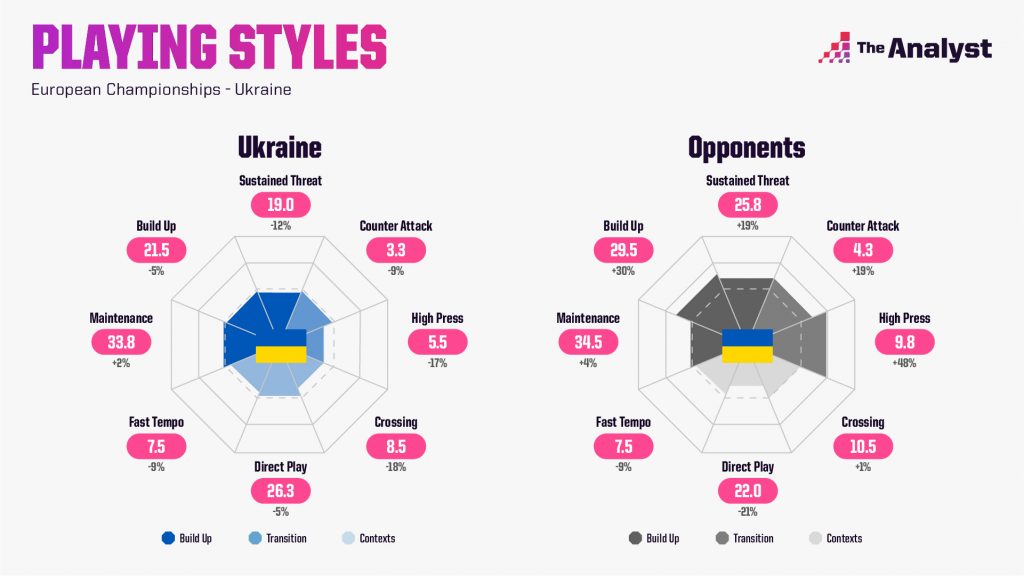
This is about as average as it gets for a remaining team, but Ukraine are a great example of why we often need to look beyond the frequency of a style and dig into that style’s efficiency. Take build up for example. Ukraine are below the competition average in such possessions, but possessions in which they use build up result in 0.8 goals per match. That’s twice the tournament average (0.4).
It’s also worth flipping this and pointing out a few opponent lack of efficiencies. As you can see on the right, build up and high press stand out as styles Ukraine’s opponents have favoured. No press against Ukraine has led to a goal yet, while their shots (4.0) and goals conceded (0.3) per match from possessions that include build up are below the tournament averages.
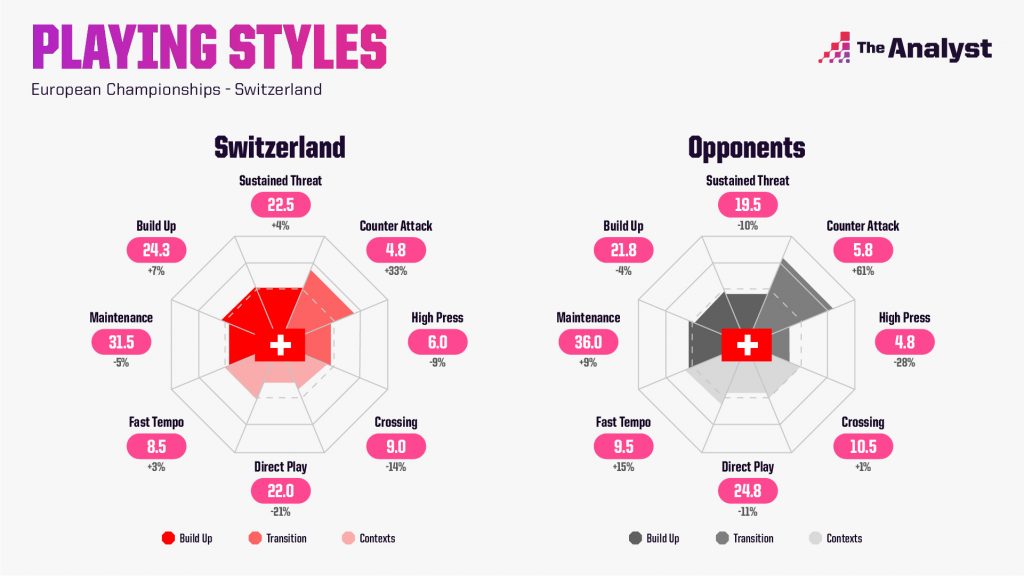
There’s not a ton of variance from tournament average here, but this isn’t the time to insert a cheap jab about Switzerland being unremarkable Switzerland. Two of their four opponents have been Italy and France. You try imposing your chosen style against those teams. They’re the only remaining team to have played two of the top six in our pre-tournament predictor and they eliminated the world champions. Perhaps the most interesting thing to point out here is just how similar Switzerland’s styles are to their opponents. They’re almost identical if you compare the two radars above, which is almost never the case.
The only style in which Switzerland fall into the top six or bottom six at Euro 2020 is counter attack, where they’re at +33% of the tournament average. For the other seven styles, they fall within the middle 12 teams. That counter has resulted in a goal – the 90th-minute goal that kept them in the tournament after Christian Fassnacht won the ball back off Paul Pogba on Switzerland’s side of midfield and Granit Xhaka played a through ball to Mario Gavranovic for the equaliser.
The counter will of course be a potential weapon against Spain, and it could be a potential weapon against Denmark for…
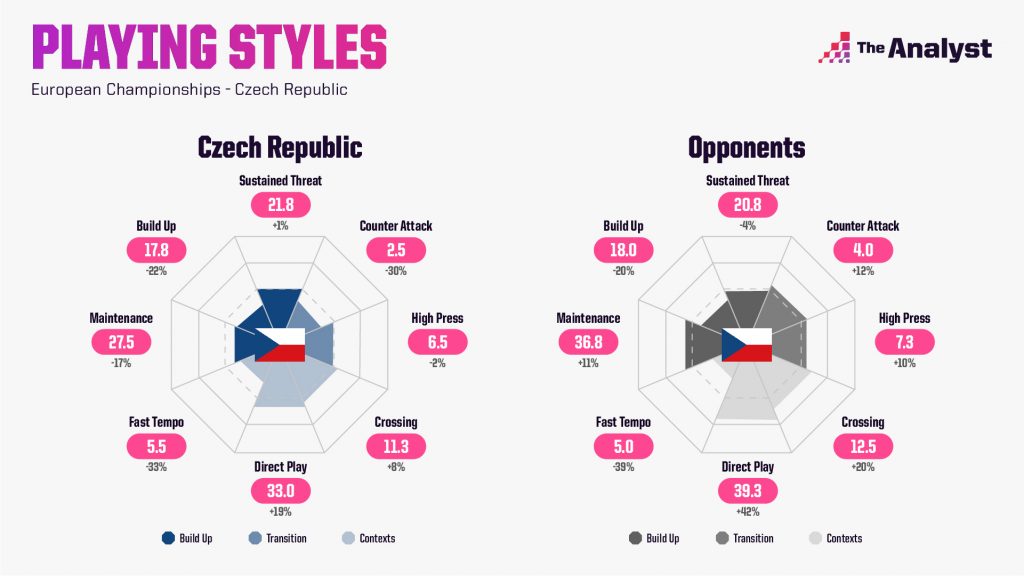
This is a playing styles radar that’s not the most interesting unless a team counters, and Jaroslav Šilhavý’s team hasn’t yet. They haven’t scored from a counter and are averaging just a third of a shot per match from counters. But they have had more sustained threat possessions than England, and if a conservative style can be good enough for England, why can’t it be good enough for the Czechs?
Their press may be something to keep an eye on against Denmark. They’ve pressed 64 sequences, which is second among teams remaining and fifth overall at Euro 2020. It’s resulted in seven shots (joint third), but it hasn’t yet yielded a goal. Denmark, Italy and the Netherlands are the only other teams with at least that many shot-ending high turnovers and they’ve all scored at least a goal, so perhaps it’s the Czech Republic’s turn.
Their most involved player in winning the ball back high up the pitch is Vladimír Coufal, but that shouldn’t come as a surprise because he’s involved in everything the Czechs do aside from their maintenance possession. No, seriously, he only accounts for 8% of their maintenance play and leads the team in sustained threat involvement (13%) and build up involvement (17%), so let’s call him either a wide playmaker or Trent Alexander-Arnold, but not a defender.
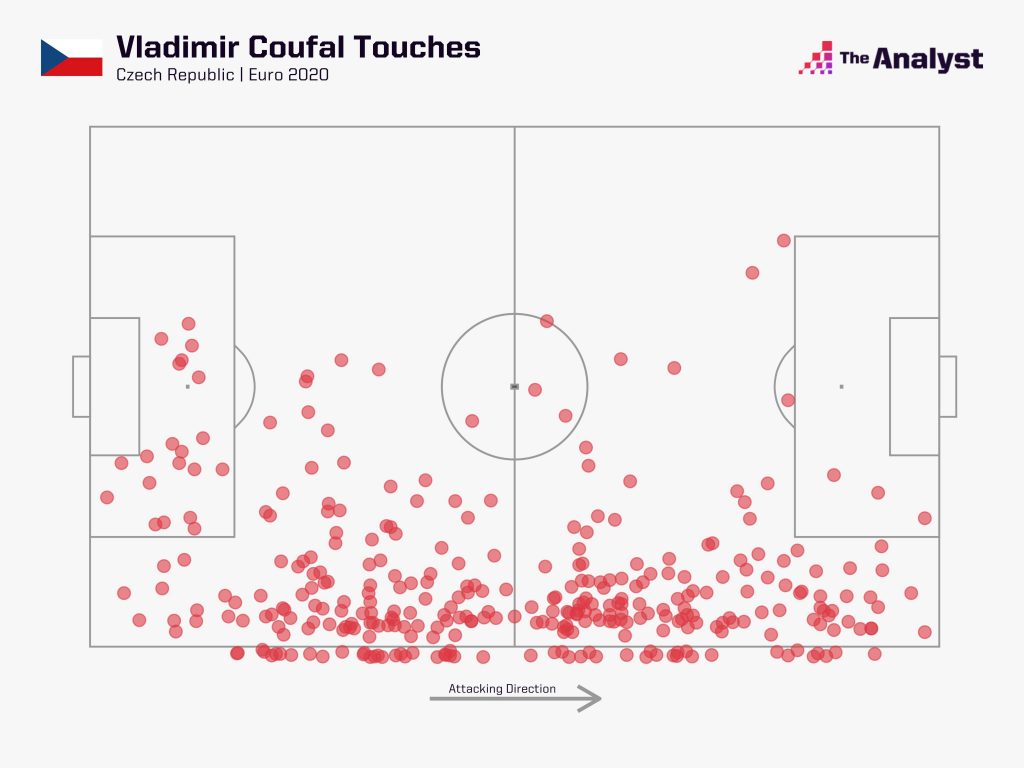
That leaves us with the team many believe(d) will win Euro 2020…
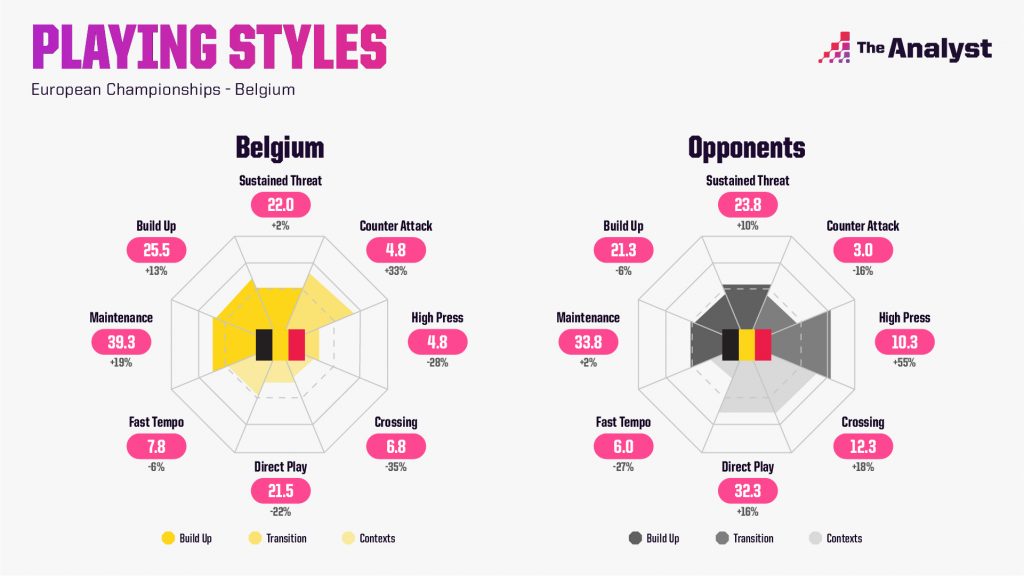
Yes, putting Belgium last here is a shameless ploy to get you to the bottom of this page. After a quick glance at their playing styles radar, we know we expected more than this. But we also expected more minutes from key players. The whitespace you see is the unofficial void left by Kevin De Bruyne and Eden Hazard. Belgium’s sequences are starting 39.2 metres from goal, which is seventh of the eight remaining teams. Only Ukraine are starting sequences deeper (37.4). So it makes sense that maintenance play (possession in one’s own half) is higher than their build up and sustained threat.
If we look at just the Finland and Denmark matches – during which De Bruyne played 135 minutes and Hazard played 121 – you’d see Belgium’s counter grow to +54% of the tournament average with sustained threat at +34%, which is more like it. That makes sense because Hazard (14%) and De Bruyne (12%) lead Belgium in sustained threat involvement when they’re out there.
Romelu Lukaku is involved far less in those phases, but he comes into play very heavily elsewhere: direct play passes received (64%), counter attack distance dribbled (32%) and crosses received (40%). Combine those phases with the fact that he’s the only player in the tournament to be involved in five goal-ending sequences and you see how dynamic Belgium could be if they’re able to play with a preferred XI.
Design by Matt Sisneros.
Enjoy this? Subscribe to receive weekly exclusive content.
